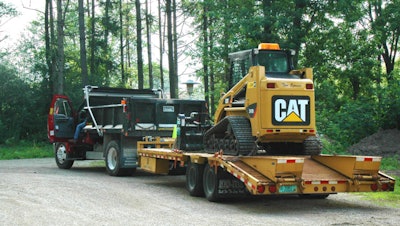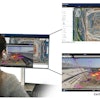
We continue in our series on Lean Construction and the seven major “wastes” found in our effort to construct quality that is safe, productive and profitable. Let’s examine the waste that can come from what is called “Transport” and see what we can do to solve it.
Transport, or transportation, is vital to every contractor of any size. Transport involves any delivery — people, equipment or materials — for any work. And Transport waste results from poor, inefficient planning that causes delay or other problems on a job.In fact, transporting people and equipment to and from the jobsites is so basic that it almost defies addressing. Yet, when Transport becomes a waste, it requires attention by the contractor.
Let’s first consider a few examples of the waste known as Transport.
- Crew drives to incorrect address
- Contractor makes multiple trips to supplier due to poor job planning
- Important materials or components for a project have no “staging area,” thus the same items are moved multiple times before use
- No local material supplier is secured so the contractor must drive farther distances to pick up material
- Contractor doesn’t have accurate logs for vehicles and thus additional mileage is put on to vehicles leading to increased risk of vehicular or equipment breakdowns
As you might surmise from the previous list of examples, planning and organization play a huge part in preventing problems that can arise from transport issues. Here are a five practical solutions you can implement into your operation with relative ease.
1. Always Pre-plan for Staging Equipment, Components, & Material
Pre-planning staging areas seems like a basic action for contractors to take, and it is. But it’s an action many contractors don’t take due simply to laziness. With many contractors running 100 mph it seems that inserting a staging plan prior to actual job start-up is a time management issue — there is simply not enough time to add one more action to the workday. Also, the actual job site might provide little to no room for such staging. (This reality is actually more common than you might think.)
However, whenever possible, take the time — make the time — to mark on a jobsite map where you want to stage trucks, trailers and equipment. Be sure to determine one-way directional flow so that all site traffic is heading in same direction to limit accidents. This last point is especially important if you are receiving material trucks from local plants or warehouses.
If you are a sub-trade contractor and do not manage the site then make sure to visit with the owner or general contractor, asking for their jobsite plan. If you don’t see your staging area then ask about creating such a space. Also, be sure to always secure the proper safety provisions for on-site transportation.
2. Create Checklists for all items needed on each vehicle and trailer
I’ve mentioned this point in previous articles but it certainly fits here. Every day that your crews head out for the day, they should have as much of their daily needs secured on their vehicles and trailers that they can safely carry. Allowing crews to simply send a driver back to pick up what someone didn’t pick up to begin the day is not acceptable and certainly adds to Transport waste.
Another waste of transporting is having a “hot truck” available. While some contractors make great use of this vehicle the vast majority of contractors I’ve observed through the years simply added this truck because of all the “hot” emergencies that could have been prevented had the contractor and foreman simply planned for every piece of equipment, tool, component and material needed for the job.
If you have a “hot truck” in your fleet, make sure you are using it wisely and that it is not being abused by field leaders. This single asset can cost you unneeded labor, fuel and maintenance dollars that siphon away profits.
3. Locate & secure accounts at area suppliers
Most contractors do a great job of developing purchasing accounts with local suppliers of tools, equipment, materials, etc. However, a sure rookie mistake is when a contractor, wanting to expand his or her geographical market, assumes they can easily set up accounts in those “far far far away” locations. This is a costly mistake just waiting to be realized.
Whether you are purposely expanding your market or taking on a project from time to time outside your normal market area, take the extra precautionary step and establish a relationship with those suppliers that your project team will need. Often this may require depositing an amount of money into a newly opened account that your project leaders can draw against when ordering materials or leasing important and needed tools or equipment.
Whatever the requirements are for those “far and away” suppliers, establish those accounts so your crews don’t spend extra time and miles driving back to your more local suppliers.
4. Keep accurate logs on vehicles and equipment
Many contractors do an adequate job keeping such logs accurate and updated, but the log keeping isn’t just to comply with your state DOT. Accurately maintained logs can also provide you with important information that strengthens much needed preventive maintenance on your vehicles, helping you to keep your vehicles and equipment better maintained, thus extending their life.
When you allow your vehicles and equipment to just run and run you eventually will pay the price. It’s like making each dollar spent on transportation begin to cost two to three dollars. This is a very easy casualty to correct and it should be one that you do ASAP!
5. Practice “zero tolerance” for providing accurate project address
This waste-prevention technique is perhaps “low hanging fruit” but it bears sharing. There is simply no excuse for any construction crew not to transport to the correct jobsite address. Granted, there are perhaps hard to find addresses but with all of the “smart phone” apps and search engine mapping processes that are available, there should be very few — make that “zero” times — when crews get lost.
Most contractors who are on their game provide a paper copy, included in the job file, of a map routing the path from the contractor’s address to the jobsite. This waste is very easy to prevent so don’t allow this cost of poor transportation to find its way into your company.
So spend some time considering the potential pitfalls from allowing your transportation to run wild without any real boundaries or clarity. Lean Construction is about reducing the costs of such wastes and empowering the contractor to perform better, faster, and with more profit!




















